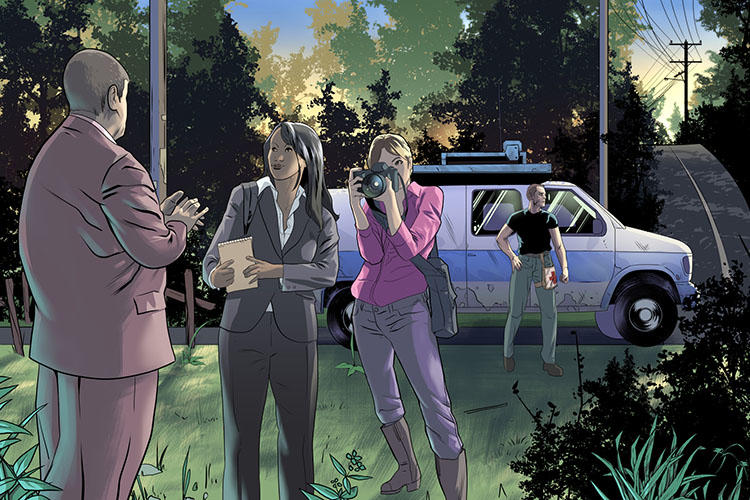Sexual violence can take many forms, including sexual and physical assaults. Any individual can be the subject of sexual misconduct, but journalists are often at risk from a range of people, including sources and members of the public, while they are reporting. That risk is heightened for female or gender non-conforming journalists.
A 2014 report by the International News Safety Institute and the International Women’s Media Foundation on safety for female journalists found that while all genders are at risk, 15 percent of female journalists experienced sexual violence in relation to their work. The following year, a U.N. Security Council debate emphasized the need for a gender-based approach to journalist safety worldwide.
Nothing can completely guarantee your safety, and sexual misconduct is never the fault of the victim. There are steps to help minimize the risk while on assignment:
When traveling:
- Conduct a risk assessment ahead of time
- Increase and maintain your situational awareness
- Avoid getting in unofficial taxis, or in taxis with strangers. Ride apps such as Uber or Lyft (if available in the country you are traveling to) allow you to share your location with a trusted person
○ Try to order a car ahead of time. Dispatched taxis are safer than ones from the street. Go with a company or driver recommended by other journalists when possible. The safest place is in the back seat, behind the driver. Don’t look at your phone during the drive: keep your head up and watch where the driver is going. Insist that the driver doesn’t pick up additional passengers
- Wherever you are traveling, understand the culture. Understand how you may be perceived in that setting
- Travel with trusted colleagues and fixers when possible. Discuss any risks or concerns you have with colleagues or editors beforehand. Staying in remote areas without a trusted companion puts you at risk
- Properly vet local fixers, translators, and drivers, including taxi companies. Try to get recommendations, especially for fixers who have worked with trusted reporters of your gender
- Choose a hotel with security guards when necessary. Avoid rooms with accessible windows or balconies, or that are on the street level. Use all available locks and a door stop
- Try to avoid using elevators or corridors where you would be alone with strangers
When working and reporting:
- Digital security and physical security should be part of any risk assessment. It is advisable to carry a cellphone with security numbers, including those of your local and professional emergency contacts, but you should also write down important numbers in case your phone is stolen or seized. Be discreet in giving out personal information
- Be cognizant of the information you are sharing online. Double-check the location sharing settings on your phone and turn them off. Block or report people who are harassing you. Online harassment can and does cross over into real life
- Always try to work with a trusted and vetted colleague, and have a regular check-in procedure with your base. Before you set out, arrange a check-in time and method with an editor or colleague, and decide how they should respond if you miss a check in
- Appear familiar and confident, and always be aware of your environment
- Don’t mingle in crowds for longer than you have to. Stay close to the edges and have an escape route planned. This is especially important in protest situations
- Be aware that necklaces, lanyards, camera straps, and other articles can be grabbed and pulled, putting your safety at risk. In protests or mass demonstrations, consider wearing a bathing suit or leotard under your clothes, and wear steel-toed shoes
- Dress to blend in with the local community. It’s important to avoid offending the local custom or culture with the clothes you wear
- Some news organizations and journalist safety trainers suggest bringing emergency contraception, in case of an attack
- When meeting with sources, choose venues and locations that are safe and public if possible. Try not to go to these meetings alone and, if necessary, let someone trusted know where, when, and with whom you are meeting
- It is important to set clear boundaries with sources, as well as with colleagues and support staff. For more information on maintaining boundaries with sources, colleagues, or supervisors, see the Dart Center for Journalism & Trauma
If you are assaulted:
- Tell your editor, supervisor or a trusted colleague what happened
- Look at advice from RAINN, a U.S.-based organization that provides services and public education to individuals who have been attacked, about the steps you can take after a sexual assault. These include possible reporting options, if you feel comfortable doing so, and information about medical attention
- You can also reach out to CPJ to document what happened
- If you are a U.S.-based journalist, many organizations can help. The U.S.-based National Sexual Violence Resource Center has a directory of organizations. Pathways to Safety International provides assistance to U.S.-based victims of gender-based violence abroad
- It is never too late to reach out about something that happened. This is easier in a newsroom or workplace where editors and colleagues encourage a culture of openness and trust
Things to consider:
- If working in a foreign country, identify a local hospital that has physicians and nurses who are fluent in your language
- Be an active bystander. Speak up if a colleague has been harassed. If safe to do so, intervene or seek assistance if you see that a colleague may be uncomfortable or facing a threat, even if the situation seems ambiguous
- Alcohol, drugs, or sleeping pills could be used to increase your vulnerability and might decrease your situational awareness
